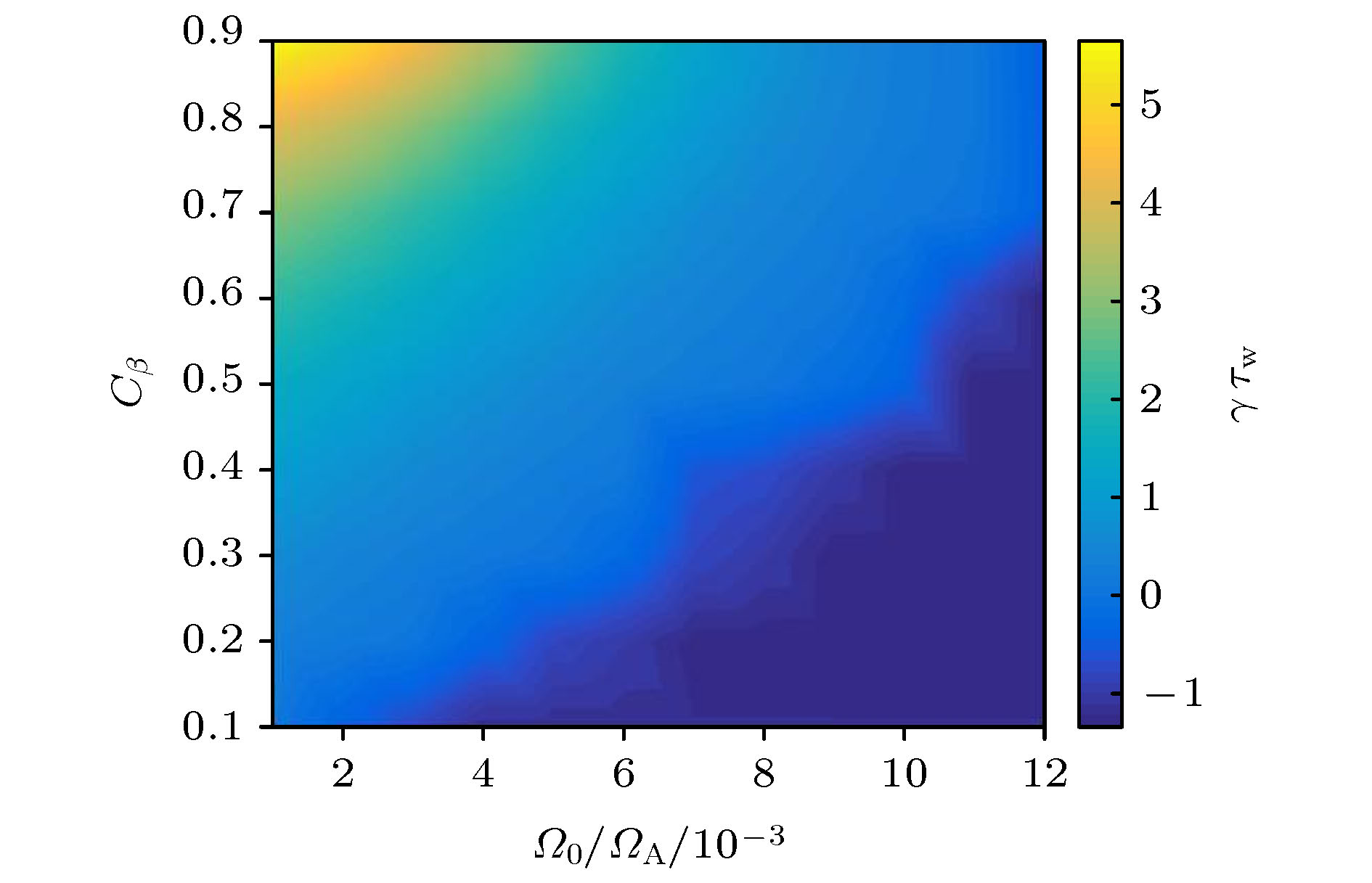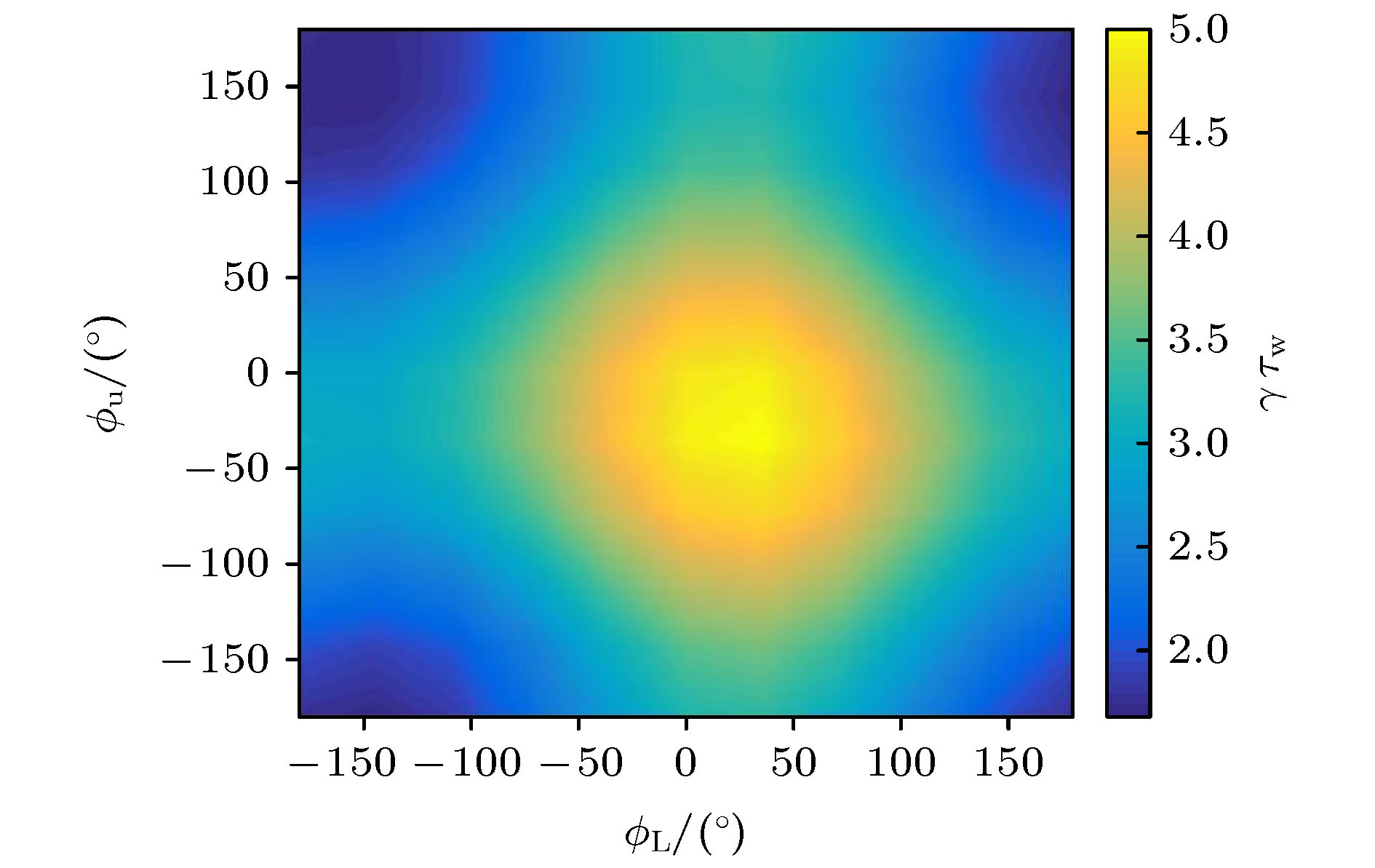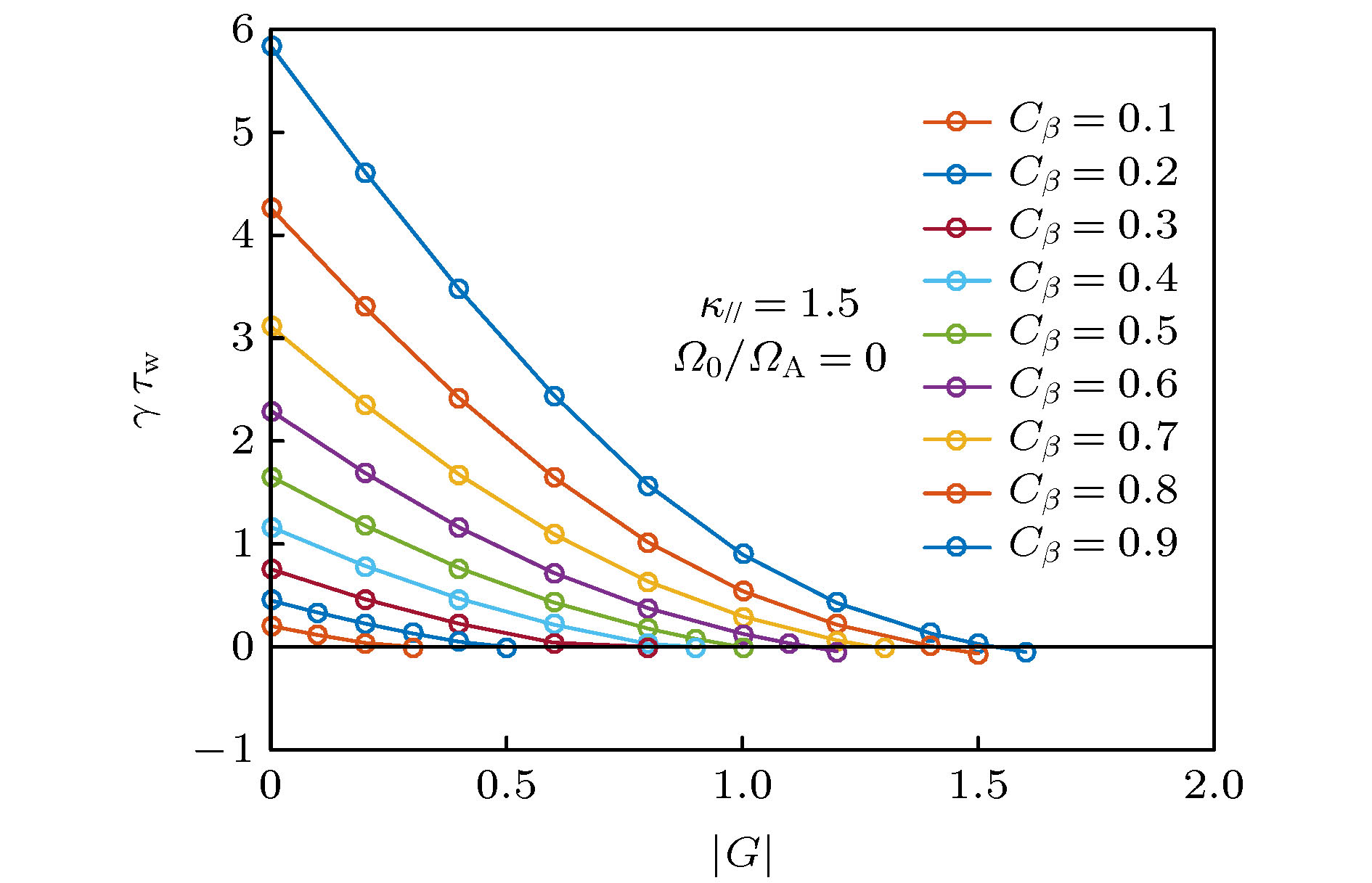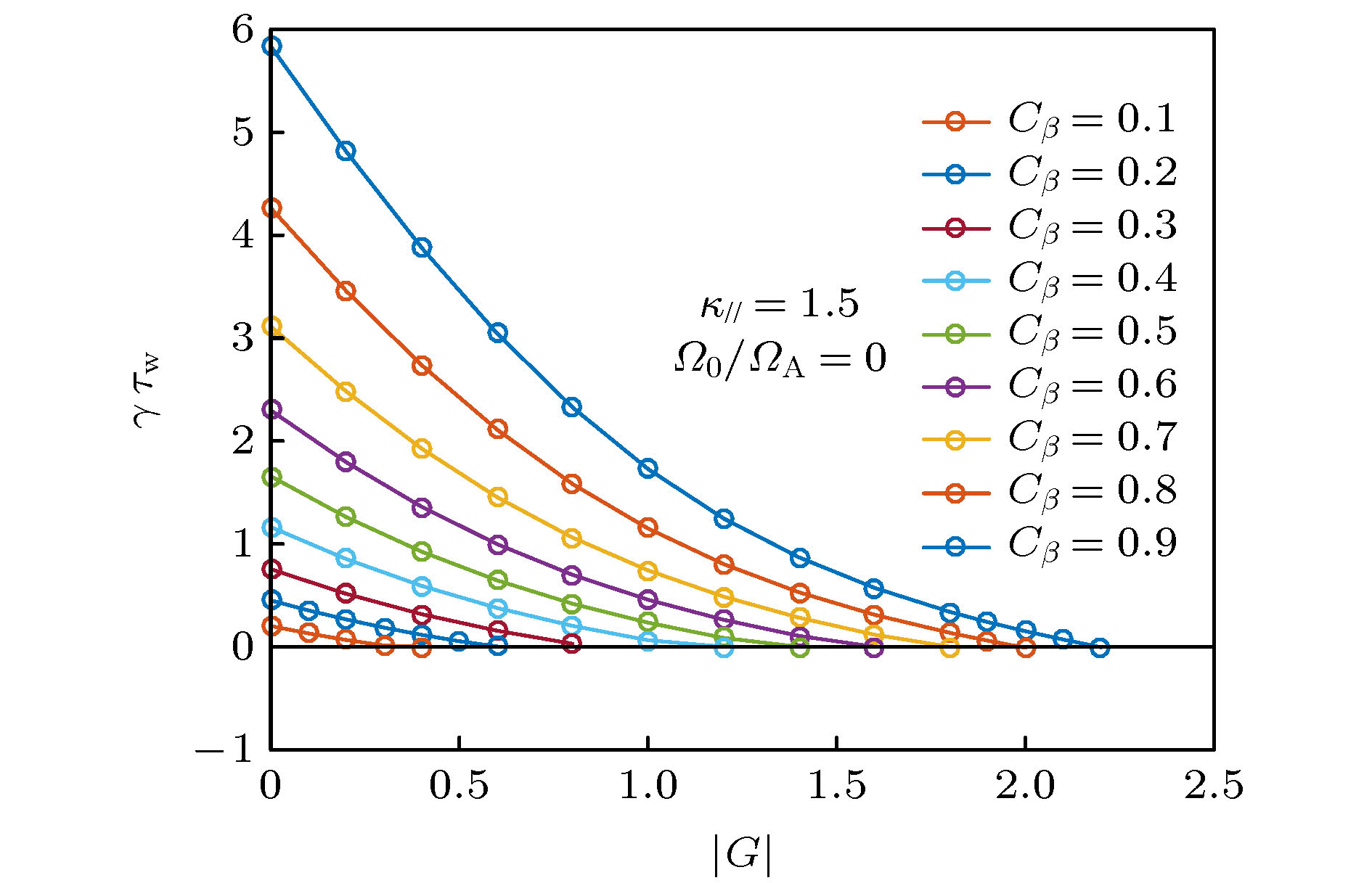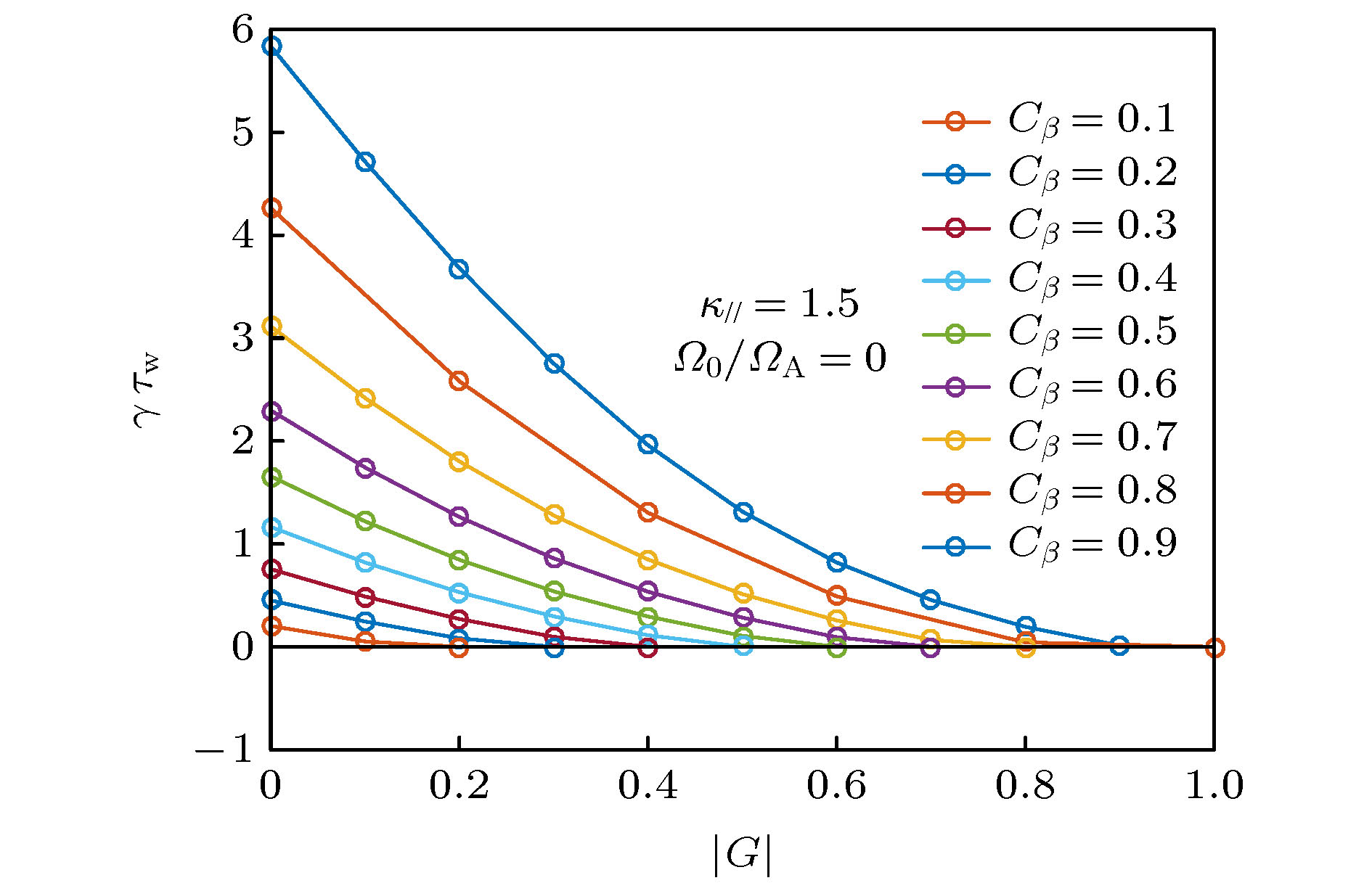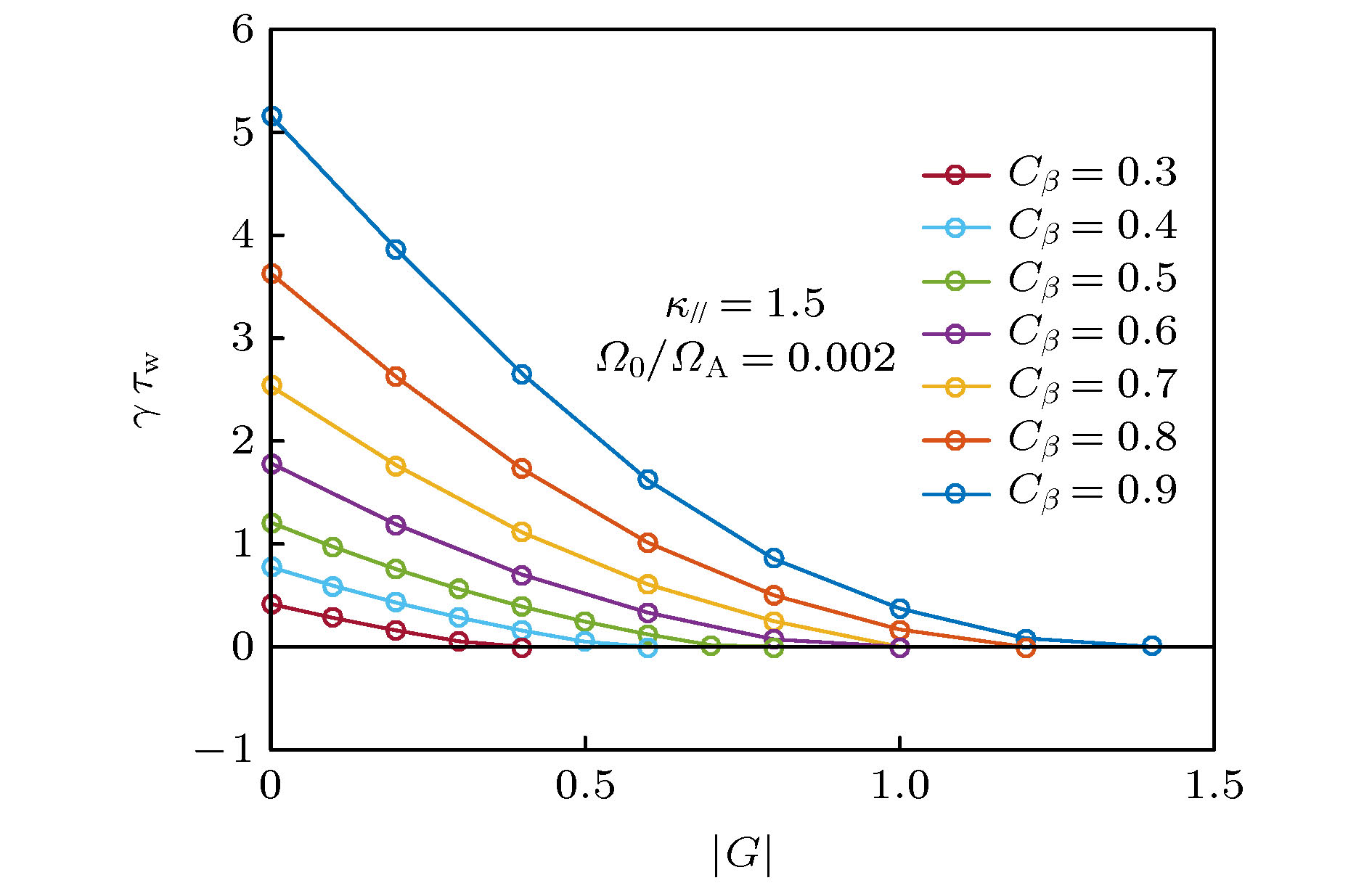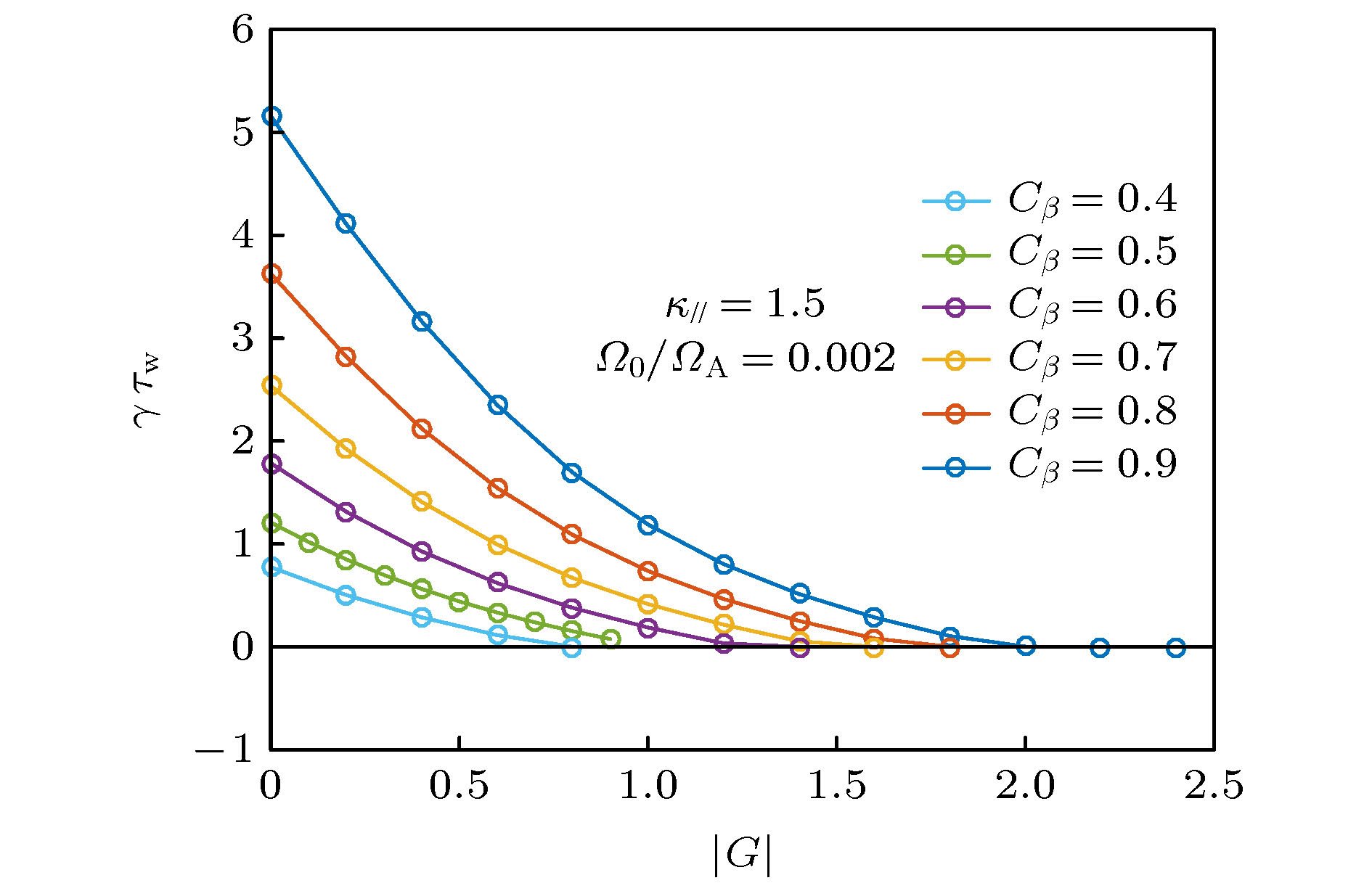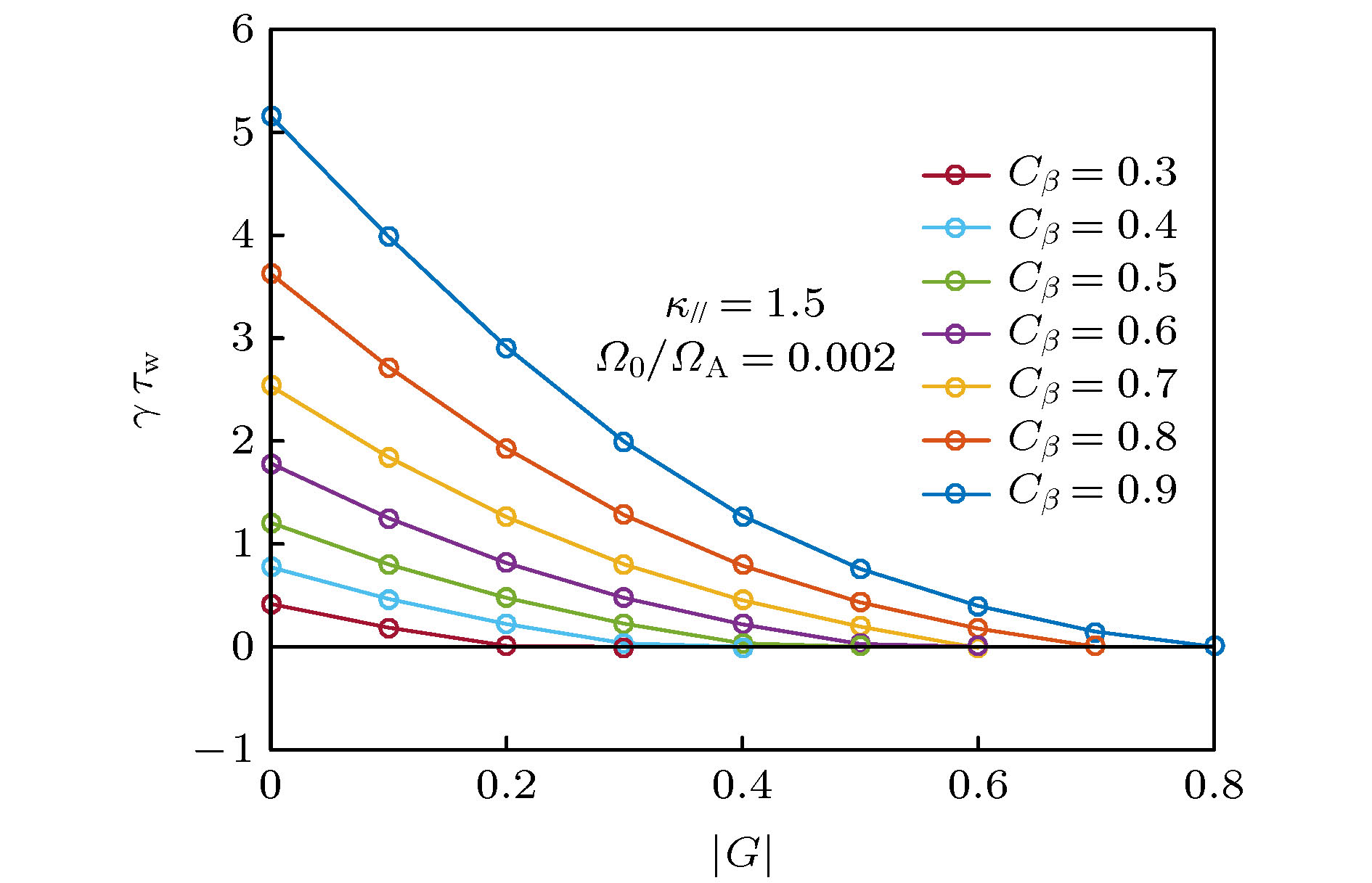-
在托卡马克等离子体中, 电阻壁模是非常重要的磁流体不稳定性, 特征时间在毫秒量级. 对长时间稳态运行下的先进托卡马克, 电阻壁模限制着聚变装置的运行参数空间(放电时间和比压), 影响经济效益, 所以研究电阻壁模稳定性至关重要. 本文使用MARS程序, 针对ITER装置上9 MA先进运行平衡位形, 研究了等离子体旋转和反馈控制对电阻壁模的影响. 结果表明, 在没有反馈控制时, 当比压参数
${C_\beta }$ 取0.7, 等离子体环向旋转频率达到1.1%的阿尔芬频率时, 可以完全稳定电阻壁模; 在等离子体环向旋转和反馈控制共同作用时, 比压参数${C_\beta }$ 取0.7, 反馈增益$|G|$ 取0.6时, 稳定电阻壁模所需要的等离子体旋转频率为0.2%的阿尔芬频率. 可见, 单独靠等离子体环向旋转稳定电阻壁模所需的旋转频率较大; 而等离子体环向旋转和反馈控制共同作用可以降低稳定电阻壁模的旋转频率临界值, 符合先进托卡马克的运行. 本文的研究结果对中国聚变工程试验堆CFETR的工程设计和运行具有一定指导意义.In tokamak plasmas, the resistive wall mode is a very important magnetohydrodynamic instability, and its time scale is on the order of millisecond. For the advanced tokamaks with long-pulse and steady-state operation, the resistive wall mode limits the operating parameter space (the discharge time and the radio of the plasma pressure to the magnetic pressure) of the fusion devices so that it affects the economic benefits. Therefore, it is very important to study the stability of the resistive wall modes in tokamaks. In this work, the influences of the plasma rotations and the feedback controls on the resistive wall modes are studied numerically using MARS code for an ITER 9 MA equilibrium designed for the advanced steady-state scenario. In the equilibrium, the profile of the safety factor has a weak negative magnetic shear in the core region. The safety factor is${q_0}= 2.44$ on the magnetic axis and${q_a}= 7.13$ on the plasma boundary. And, the minimum safety factor${q_{\min }}$ is 1.60. The structure of this kind of weakly negative magnetic shear can generate higher radio of the plasma pressure to the magnetic pressure and it is the important feature of the advanced steady-state scenario. Using MARS code, for two cases: without wall and with ideal wall, the results of growth rates of the external kink modes for different values of${\beta _{\rm N}}$ are obtained. The limit value of$\beta _{\rm N}^\text{no-wall}$ is 2.49 for the case without wall, and the limit value of$\beta _{\rm N}^\text{ideal-wall}$ is 3.48 for the case with ideal wall. Then, a parameter${C_\beta } = \left( {{\beta _{\rm{N}}} - \beta _{\rm{N}}^{{\text{no-wall}}}} \right)/\left( {\beta _{\rm{N}}^{{\text{ideal-wall }}} - \beta _{\rm{N}}^{{\text{no-wall }}}} \right)$ is defined. The research results in this work show that with the plasma pressure scaling factor${C_\beta } = 0.7$ and plasma rotation frequency${\Omega _{0}} = 1.1\% {\Omega _A}$ , the resistive wall modes can be completely stabilized without feedback control. And, with the plasma pressure scaling factor${C_\beta } = 0.7$ and the feedback gain$\left| G \right| = 0.6$ , only plasma rotation with the frequency${\Omega _{0}} = 0.2\% {\Omega _A}$ can stabilize the resistive wall modes. Therefore, a faster plasma rotation is required to stabilize the resistive wall modes by the plasma flow alone. The synergetic effects of the feedback and the toroidal plasma flow on the stability of the RWM can reduce plasma rotation threshold, which satisfies the requirements for the operation of the advanced tokamaks. The conclusion of this work has a certain reference for the engineering design and the operation of CFETR.-
Keywords:
- resistive wall mode /
- plasma flow /
- magnetic feedback
[1] Haney S W, Freidberg J P 1989 Phys. Plasmas 1 1637
[2] Matsunaga G, Takechi M, Kurita G, Ozeki T, Kamada Y, Team t J T 2007 Plasma Phys. Controlled Fusion 49 95
 Google Scholar
Google Scholar
[3] Gimblett C G 1986 Nucl. Fusion 26 617
 Google Scholar
Google Scholar
[4] Pfirsch D, Tasso H 1971 Nucl. Fusion 11 259
 Google Scholar
Google Scholar
[5] Liu Y, Bondeson A, Gribov Y, Polevoi A 2004 Nucl. Fusion 44 232
 Google Scholar
Google Scholar
[6] Xia G, Liu Y, Liu Y 2014 Plasma Phys. Controlled Fusion 56 095009
 Google Scholar
Google Scholar
[7] Xia G, Liu Y, Liu Y, Hao G Z, Li L 2015 Nucl. Fusion 55 093007
 Google Scholar
Google Scholar
[8] Liu C, Liu Y, Liu Y, Hao G, Li L, Wang Z 2015 Nucl. Fusion 55 063022
 Google Scholar
Google Scholar
[9] Hao G Z, Wang A K, Liu Y Q, Qiu X M 2011 Phys. Rev. Lett. 107 015001
 Google Scholar
Google Scholar
[10] Hao G Z, Liu Y Q, Wang A K, Jiang H B, Lu G M, He H D, Qiu X M 2011 Phys. Plasmas 18 032513
 Google Scholar
Google Scholar
[11] Hao G Z, Liu Y Q, Wang A K, Chen H T, Miao Y T, Wang S, Zhang N, Dong G Q, Xu M 2020 Plasma Phys. Controlled Fusion 62 075007
 Google Scholar
Google Scholar
[12] Wang S, Liu Y Q, Zheng G Y, Song X M, Hao G Z, Xia G L, Li L, Li B, Zhang N, Dong G Q, Bai X 2019 Nucl. Fusion 59 096021
 Google Scholar
Google Scholar
[13] Chu M S, Greene J M, Jensen T H, Miller R L, Bondeson A, Johnson R W, Mauel M E 1995 Phys. Plasmas 2 2236
 Google Scholar
Google Scholar
[14] Ward D J, Bondeson A 1995 Phys. Plasmas 2 1570
 Google Scholar
Google Scholar
[15] Garofalo A M, Jackson G L, La Haye R J, Okabayashi M, Reimerdes H, Strait E J, Ferron J R, Groebner R J, In Y, Lanctot M J, Matsunaga G, Navratil G A, Solomon W M, Takahashi H, Takechi M, Turnbull A D, Team D D 2007 Nucl. Fusion 47 1121
 Google Scholar
Google Scholar
[16] Liu Y Q, Bondeson A, Fransson C M, Lennartson B, Breitholtz C 2000 Phys. Plasmas 7 3681
 Google Scholar
Google Scholar
[17] Liu Y, Chu M S, Chapman I T, Hender T C 2008 Phys. Plasmas 15 112503
 Google Scholar
Google Scholar
[18] Wang Z R, Guo S C, Liu Y Q, Chu M S 2012 Nucl. Fusion 52 063001
 Google Scholar
Google Scholar
[19] Chu M S, Greene J M, Jensen T H, Miller R L, Bondeson A, Johnson R W, Mauel M E 1995 Physics Plasmas 2 2236
[20] Li L, Liu Y, Liu Y Q 2012 Phys. Plasmas 19 012502
 Google Scholar
Google Scholar
-
图 2 ITER装置9 MA先进运行平衡 (a)安全因子剖面; (b)等离子体压强剖面, 由
${B_0}^2/{\mu _0}$ 归一化; (c)质量密度剖面, 磁轴处归一化为1; (d)环向电流密度剖面, 由${B_{0}}/\left( {{\mu _0}{R_0}} \right)$ 归一化,$s = \sqrt \psi $ ,$\psi $ 是归一化的极向通量Fig. 2. Radial profiles of (a)safety factor; (b)equilibrium pressure normalized by factor
${B_0}^2/{\mu _0}$ ; (c)plasma density normalized to unity at the magnetic axis; (d)toroidal current density normalized by factor${B_{0}}/\left( {{\mu _0}{R_0}} \right)$ and$s = \sqrt \psi $ ,$\psi $ is the normalized poloidal flux for ITER target plasma designed for 9 MA steady state scenario.图 8 在没有等离子体旋转频率、平行黏滞
${\kappa _{/\!/} } =1.5$ 时, 不同的等离子体比压参量, 不同中间线圈的增益下电阻壁模的增长率变化Fig. 8. Without plasma flow and with parallel viscous coefficient
${\kappa _{/\!/} }=1.5$ , growth rate of resistive wall mode with varying equilibrium pressure scaling factor versus feedback gains for middle sets of active coils.图 9 在没有等离子体旋转频率、平行黏滞
${\kappa _{/\!/}} =1.5$ 时, 不同的等离子体比压参量, 不同上下两组线圈的增益下电阻壁模的增长率变化Fig. 9. Without plasma flow and with parallel viscous coefficient
${\kappa _{/\!/}}=1.5$ , growth rate of resistive wall mode with varying equilibrium pressure scaling factor versus feedback gains for upper and lower sets of active coils.图 10 在没有等离子体旋转频率、平行黏滞
${\kappa _{/\!/} } =1.5$ 时, 不同的等离子体比压参量, 不同上中下三组线圈的增益下电阻壁模的增长率变化Fig. 10. Without plasma flow and with parallel viscous coefficient
${\kappa _{/\!/} }=1.5$ , growth rate of resistive wall mode with varying equilibrium pressure scaling factor versus feedback gains for all three sets of active coils.图 11 在等离子体旋转频率
${\varOmega _{0}}/{\varOmega _{\rm{A}}}$ = 0.002、平行黏滞${\kappa _{/\!/} }=1.5$ 时, 不同的等离子体比压参量, 加上旋转后中间线圈的增益和增长率的变化Fig. 11. With plasma flow
${\varOmega _{0}}/{\varOmega _{\rm{A}}}$ = 0.002 and parallel viscous coefficient${\kappa _{/\!/} }=1.5$ , growth rate of resistive wall mode with varying equilibrium pressure scaling factor versus feedback gains for middle sets of active coils.图 12 在等离子体旋转频率
${\varOmega _{0}}/{\varOmega _{\rm{A}}}$ = 0.002、平行黏滞${\kappa _{/\!/} }=1.5$ 时, 不同的等离子体比压参量, 加上旋转后上下两组线圈的增益和增长率的变化Fig. 12. With plasma flow
${\varOmega _{0}}/{\varOmega _{\rm{A}}}$ = 0.002 and parallel viscous coefficient${\kappa _{/\!/} }=1.5$ , growth rate of resistive wall mode with varying equilibrium pressure scaling factor versus feedback gains for upper and lower sets of active coils.图 13 在等离子体旋转频率
${\varOmega _{0}}/{\varOmega _{\rm{A}}}$ = 0.002、平行黏滞${\kappa _{/\!/}}=1.5$ 时, 不同的等离子体比压参量, 加上旋转后上中下三组线圈的增益和增长率的变化Fig. 13. With plasma flow
${\varOmega _{0}}/{\varOmega _{\rm{A}}}$ = 0.002 and parallel viscous coefficient${\kappa _{/\!/} }=1.5$ , growth rate of resistive wall mode with varying equilibrium pressure scaling factor versus feedback gains for all three sets of active coils. -
[1] Haney S W, Freidberg J P 1989 Phys. Plasmas 1 1637
[2] Matsunaga G, Takechi M, Kurita G, Ozeki T, Kamada Y, Team t J T 2007 Plasma Phys. Controlled Fusion 49 95
 Google Scholar
Google Scholar
[3] Gimblett C G 1986 Nucl. Fusion 26 617
 Google Scholar
Google Scholar
[4] Pfirsch D, Tasso H 1971 Nucl. Fusion 11 259
 Google Scholar
Google Scholar
[5] Liu Y, Bondeson A, Gribov Y, Polevoi A 2004 Nucl. Fusion 44 232
 Google Scholar
Google Scholar
[6] Xia G, Liu Y, Liu Y 2014 Plasma Phys. Controlled Fusion 56 095009
 Google Scholar
Google Scholar
[7] Xia G, Liu Y, Liu Y, Hao G Z, Li L 2015 Nucl. Fusion 55 093007
 Google Scholar
Google Scholar
[8] Liu C, Liu Y, Liu Y, Hao G, Li L, Wang Z 2015 Nucl. Fusion 55 063022
 Google Scholar
Google Scholar
[9] Hao G Z, Wang A K, Liu Y Q, Qiu X M 2011 Phys. Rev. Lett. 107 015001
 Google Scholar
Google Scholar
[10] Hao G Z, Liu Y Q, Wang A K, Jiang H B, Lu G M, He H D, Qiu X M 2011 Phys. Plasmas 18 032513
 Google Scholar
Google Scholar
[11] Hao G Z, Liu Y Q, Wang A K, Chen H T, Miao Y T, Wang S, Zhang N, Dong G Q, Xu M 2020 Plasma Phys. Controlled Fusion 62 075007
 Google Scholar
Google Scholar
[12] Wang S, Liu Y Q, Zheng G Y, Song X M, Hao G Z, Xia G L, Li L, Li B, Zhang N, Dong G Q, Bai X 2019 Nucl. Fusion 59 096021
 Google Scholar
Google Scholar
[13] Chu M S, Greene J M, Jensen T H, Miller R L, Bondeson A, Johnson R W, Mauel M E 1995 Phys. Plasmas 2 2236
 Google Scholar
Google Scholar
[14] Ward D J, Bondeson A 1995 Phys. Plasmas 2 1570
 Google Scholar
Google Scholar
[15] Garofalo A M, Jackson G L, La Haye R J, Okabayashi M, Reimerdes H, Strait E J, Ferron J R, Groebner R J, In Y, Lanctot M J, Matsunaga G, Navratil G A, Solomon W M, Takahashi H, Takechi M, Turnbull A D, Team D D 2007 Nucl. Fusion 47 1121
 Google Scholar
Google Scholar
[16] Liu Y Q, Bondeson A, Fransson C M, Lennartson B, Breitholtz C 2000 Phys. Plasmas 7 3681
 Google Scholar
Google Scholar
[17] Liu Y, Chu M S, Chapman I T, Hender T C 2008 Phys. Plasmas 15 112503
 Google Scholar
Google Scholar
[18] Wang Z R, Guo S C, Liu Y Q, Chu M S 2012 Nucl. Fusion 52 063001
 Google Scholar
Google Scholar
[19] Chu M S, Greene J M, Jensen T H, Miller R L, Bondeson A, Johnson R W, Mauel M E 1995 Physics Plasmas 2 2236
[20] Li L, Liu Y, Liu Y Q 2012 Phys. Plasmas 19 012502
 Google Scholar
Google Scholar
计量
- 文章访问数: 7284
- PDF下载量: 81
- 被引次数: 0



























 下载:
下载:
















